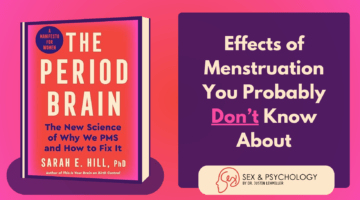What Men Who Use Sex Toys Know That You Don’t
November 2, 2020 by Justin Lehmiller
**Note: This post is sponsored by bestblowjobmachines.com
When it comes to sex toy use, there is a pretty sizeable gap between men and women. Studies have consistently found that women use sex toys during masturbation at much higher rates compared to men.
For example, in a national online study of 1,723 heterosexual adults in Germany published earlier this year, 45% of the overall sample said they had used a sex toy during masturbation before; however, when broken down by gender, the numbers were 53% for women and 37% for men [1].
The fact that a sizeable gender gap in sex toy use exists in Germany—a pretty sexually liberal and sex-positive culture—is notable in and of itself. However, it is also interesting to compare these results to findings from somewhat more sexually conservative cultures, such as the United States.
For example, in national samples from the U.S., researchers have found that 46% of women and 17% of men say they’ve used a sex toy during masturbation at some point in their lives [2,3]. Thus, the gender gap persists across cultures, with women being substantially more likely to have used toys. However, in more sex-positive cultures, the gap seems to be a bit smaller and the total number of men who have used sex toys seems to be a big higher.
Any way you look at it, though, most men aren’t using sex toys during masturbation—and research suggests that they might be missing out. For example, when asked about the effects of sex toy use on their sex lives, men overwhelmingly report positive effects [1], so there is something to potentially be gained through enhanced pleasure and fulfillment. This is at least partly because sex toys are a form of sexual novelty—they allow us to try something new and experience some different sensations. However, that’s not all.
The most commonly used sex toys among men are devices that stimulate the penis, and there’s actually research showing that some of these toys can potentially help men to overcome certain sexual difficulties. For example, masturbation sleeves have been used as a successful treatment for both premature ejaculation and delayed orgasm [4,5], perhaps because they can help men to develop better ejaculatory control with practice. Findings like this may help to explain why men who use sex toys tend to report better sexual functioning overall [2].
For men who might be thinking about using sex toys for the first time, where do you even begin? There are endless options, which can make the search seem rather daunting. Fortunately, our friends over at Best Blowjob Machines have put together a handy guide to hands-free pleasure if you’re on the market for a male masturbator.
Their site offers in-depth reviews of some of the most popular masturbation devices on the market. They explore the different features, unique pros and cons, tips for how to make the most out of your experience, and answer common questions (e.g., where to buy, what they’re made of, how long they last, etc.). They also include photos and videos (non-explicit) so that you can see what the products look like and how they work.
Most of the products they review are essentially blowjob machines, and while the general concept behind them is similar, they each have some distinct qualities. For example, some have a pause button you can use if you’re trying to “edge” or stay on the brink of orgasm longer (something that might be particularly helpful for those specifically seeking to gain better ejaculatory control). Others have companion apps you can download so you can control the device with your phone. And yet others allow you to adjust tightness and suction so that you can customize the experience to your body and preferences.
There’s a lot to consider, so check them out and find what’s best for you. Just remember that there isn’t any shame in using sex toys, and that guys who use them tend to be more sexually satisfied. So if you give them a try, you might find that they give your sex life a boost.
And just in case you need another excuse to explore the world of sex toys, National Sex Toy Day is coming up on November 4!
Want to learn more about Sex and Psychology? Click here for previous articles or follow the blog on Facebook (facebook.com/psychologyofsex), Twitter (@JustinLehmiller), or Reddit (reddit.com/r/psychologyofsex) to receive updates. You can also follow Dr. Lehmiller on YouTube and Instagram.
[1] Döring, N., & Poeschl, S. (2020). Experiences with diverse sex toys among German heterosexual adults: Findings from a national online survey. The Journal of Sex Research, 57(7), 885-896.
[2] Reece, M., Herbenick, D., Sanders, S. A., Dodge, B., Ghassemi, A., & Fortenberry, J. D. (2009). Prevalence and characteristics of vibrator use by men in the United States. The Journal of Sexual Medicine, 6(7), 1867-1874.
[3] Herbenick, D., Reece, M., Sanders, S., Dodge, B., Ghassemi, A., & Fortenberry, J. D. (2009). Prevalence and characteristics of vibrator use by women in the United States: Results from a nationally representative study. The Journal of Sexual Medicine, 6(7), 1857-1866.
[4] Rodríguez, J. E., & López, A. (2016). Male masturbation device for the treatment of premature ejaculation. Asian Pacific Journal of Reproduction, 5(1), 80-83.
[5] Rodriguez, J. E., Picazo, J. A., & Lopez, E. (2017). Male masturbation device for the treatment of delayed ejaculation: A case report. Asian Pacific Journal of Reproduction, 6(4), 191.
Image Source: 123RF/Iakov Filimonov
You Might Also Like:

Dr. Justin Lehmiller
Founder & Owner of Sex and PsychologyDr. Justin Lehmiller is a social psychologist and Research Fellow at The Kinsey Institute. He runs the Sex and Psychology blog and podcast and is author of the popular book Tell Me What You Want. Dr. Lehmiller is an award-winning educator, and a prolific researcher who has published more than 50 academic works.
Read full bio >


